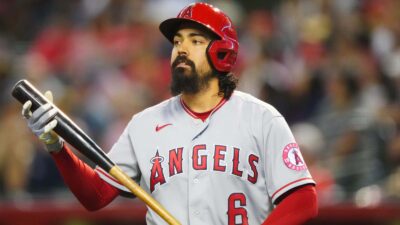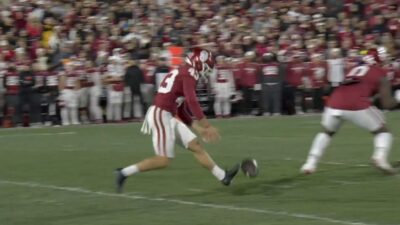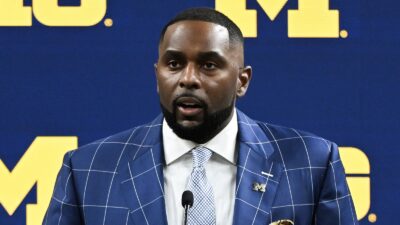 It’s America’s favorite pastime: heckling and lambasting umpires. This activity may not be the most productive, but, hey, it beats the heck out of having to read those verbose rule books. The fan Code of Conduct can easily be summed up as: The uniformed official deserves as much of your scorn as humanly possible, and then some. There is an old saying in officiating, that if half the crowd is mad and the other half ecstatic, you probably got the call right. Of course, I was never good with fractions anyway, so I’m not going to ask about the third half.
It’s America’s favorite pastime: heckling and lambasting umpires. This activity may not be the most productive, but, hey, it beats the heck out of having to read those verbose rule books. The fan Code of Conduct can easily be summed up as: The uniformed official deserves as much of your scorn as humanly possible, and then some. There is an old saying in officiating, that if half the crowd is mad and the other half ecstatic, you probably got the call right. Of course, I was never good with fractions anyway, so I’m not going to ask about the third half.
Being a professional arbiter is never an easy proposition. Having to wear uniforms that clash with everything. If you’re an NBA referee, you’re wearing that drab grey get-up. Football and hockey refs look like old-time convicts in their traditional black-and-white stripes; just replace the whistle with a ball-and-chain and pick axe to complete the look. You can’t miss the officials in soccer. They are, invariably, the fluorescent nightmare right in the middle of your picture. Baseball umpires would blend in with the scenery if not for their navy blue numbers (reminiscent of the Union army’s uniforms that were popular about a sesquicentennial ago) and their propensity to infuriate between thirty and fifty-thousand spectators on a given night.
If the clothing wasn’t bad enough (think: school uniforms), then how about the lack of reverence shown for the slightly rotund men in uniform? No one has ever been spotted waiting outside Harry Wendlestedt’s umpiring school with pen and paper in hand, unless the paper contained some kind of restraining order. I’m not sure how many balls Nestor Chylak, Bill Klem, and Bruce Froemming signed and, presumably, Jocko Conlan probably wasn’t the subject of idol worship by too many in his day. You won’t see a high-five for a gutsy “out” call made at home-plate, a fist bump initiated for timely application of the Infield Fly Rule, or anyone getting mobbed at home-plate for a walk-off strike out call. The more likely reaction is the one witnessed in 2006, when Delmon Young went batty and threw his lumber at an umpire in the minor leagues (see what I did there?). Or, that time when Jose Offerman got the quick hook from an ump and responded with a right hook of his own.
Quite simply, most people don’t have an affinity for umpires. No one has ever given someone in blue a standing ovation for making a gutsy call on a bang-bang play. There are no umpire fantasy leagues. An umpire’s visage has never graced the front of a trading card (for better or worse). Not once in the history of mankind has anyone ever paused and rewound their DVR player to get another glimpse at a good call. Come to think of it bad calls are instantly replayed on TV all the time, not good ones. There probably have never been any ballpark conversations where one yearns for the days when American League home-plate umpires had those balloon-style chest protectors that looked like a padded rack of spare ribs on their uniform. For crying out loud, they even get booed during rain delays!
Think of all the umpires that come to mind right now. You might be able to conjure Jim Joyce, who was demonized as the Motor City Madman after his missed call at first base cost the Tigers’ Armando Galarraga a perfect game last season. Don Denkinger had “The Call” in the 1985 World Series. It doesn’t quite have the allure of The Catch, The Drive, or The Shot, but it was enough to seal his place in infamy and help secure a World Series for the Iorg mantle: Party on Dane, Party on Garth! The 2005 ALCS will best be remembered for Doug Eddings’ miscall (No call?) on an alleged dropped third-strike swung at by A.J. Pierzynski. The controversial play in Game 3 of the White Sox-Angels series emboldened Chicago, which won its first World Series title since 1917, as well as antidisestablishmentarians — finally worked that word into an article — who went on to bigger (no), better (no), well, other things, such as naming a website after said umpire likening him to a feminine hygiene product. Just like how one play, one astounding feat can define an athlete’s career and legacy, so it is that a mistake can have a negative imprint for the game’s overseers. For more reading info on the topic, look up Tim McClelland and George Brett; Tim McClelland and the Rockies-Padres play-in game in 2007; and Tim McClelland forgetting the old “tag, you’re out” rule during the 2009 ALCS.
To the umps’ credit (first time that’s been uttered), of all the major sports, they are the only arbiters who, from the time the event starts until its eventual conclusion, have to stand out on the field of play without any halftime or intermission intervals. Imagine having to stand in front of tens of thousands of fans scrutinizing every play from their seats, some fueled on anger over a call, others on anger over high-priced, watered-down stadium beer. This sport, unlike most others, has no clock, so the four umpires (six during the postseason) stand under the bright stadium lights in “Deer Hunter” fashion, and therefore have no idea how long they will be out there, having to be as sharp in the first inning as, say, the nineteenth.
Well, that could not be said about Jerry Meals last week. Appropriately it was him, since pundits have been feasting on Meals since his blown call in the Braves-Pirates game. A 3-3 game, one inning shy of a full score, a groundball was hit to third base. The throw came home in plenty of time for Pittsburgh catcher Mike McKenry to tag out Julio Lugo for the second out of the inning. It was clearly an out to everyone, even to the bleary-eyed Atlanta fans who were still watching at almost two in the morning. Meals called him safe. Normally this contest, especially in the middle of July, would be filed in the annals of “Who cares?” Most of the country was asleep or not longer paying attention to the game. Unfortunately, Meals was in that group.
Following the game, after probably viewing the replays like the Zapruder Film Festival, Meals admitted fault in missing the call, and like cohorts Joyce and Denkinger before him, joined an ignominious umpiring fraternity. Meals has been umpiring for 14 years in the Majors and, prior to last Wednesday night, you probably didn’t know him from Adam or, if you did, could not have remembered one game he had previously umpired. How many ballplayers can you say that about? In one night, on one single play, an umpiring career spanning nearly a decade-and-a-half and thousands of calls has become defined by one miscue.
Imagine that. Getting it right thousands of times, fine. But, the one missed play, even as egregious as it was, and you become demonized for life. Meals probably might want to fast the next time he visits Pittsburgh. I’ll tell you, if I had the book thrown at me for every instance of dangling modifiers, syntax, or an improper semicolon, I probably would have been impaled by Webster’s already.
Umpires are simply a part of the game of baseball, as much as the green grass, the chalked lines, and the overpaid, underperforming right fielder. Most of them spend their entire careers cloaked in anonymity. The ones that don’t are usually known more for their mistakes than anything else. But remember, folks, where would be without the Blue to help guide us through all the intricacies contained within the rules? Because at the old ballgame, it’s one, two… Uh, I forget how that part goes.













